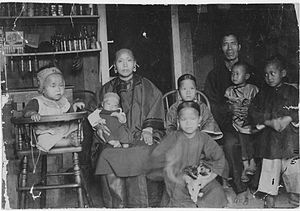Chinese immigration to Hawaii
  Zhōnghuá Mínguó Guóqí (Pre-communist China) Wǔ Xīng Hóng Qí | ||||||||||
| ||||||||||
| Total population | ||||||||||
|---|---|---|---|---|---|---|---|---|---|---|
| 198,711 (2010) [1] | ||||||||||
| Languages | ||||||||||
| Cantonese, English, Hawaiian | ||||||||||
| Religion | ||||||||||
| Roman Catholicism, Protestantism Buddhism, Confucianism, Taoism | ||||||||||
The Chinese in Hawaiʻi, frequently referred to by their Hawaiian name Pākē, constitute about 4.7% of the state's population, most of whom (75%) have ancestors from Zhongshan in Guangdong. This number does not include people of mixed Chinese and Hawaiian descent. If all people with Chinese ancestry in Hawaiʻi (including the Chinese-Hawaiians) are included, they form about 1/3 of Hawaii's entire population. As United States citizens, they are a group of Chinese Americans.
Origins
Historical records indicated that the earliest immigration of the Chinese came from Guangdong province: a few sailors in 1778 with Captain Cook's journey, more in 1788 with Kaina, and some in 1789 with an American trader who settled in Hawaiʻi in the late 18th century.

By 1790, a handful of Chinese lived on the island of Oʻahu, including the 1789 group. They lived together with the chief Kamehameha the Great. Because these Chinese men had not brought any Chinese women along with them, they intermarried with Hawaiian women. They became assimilated and created Chinese-Hawaiian surnames like Akaka, Ahina, etc., in which words of Chinese origin are pronounced with a soft Hawaiian tone. The practice of intermarrying with Hawaiian women continued well into the 19th century, when Chinese women were still a rarity in Hawaiiʻi.
Most of the Chinese immigrants to Hawaii arrived in the mid-to-late 19th century, when 46,000 people immigrated to the islands. Although many came as laborers for sugar plantations in Hawaii, they concentrated on getting education for their children. When their contracts expired, many decided to remain in Hawaii and opened businesses in areas such as Chinatown. By 1950 most Chinese American men in Hawaii were educated and held good jobs. Today 95% of Chinese Americans in Hawaii live in Honolulu and work at professional jobs.
The majority of marriages between Chinese men and white women in Hawaii were with Portuguese women.[2][3][4] Portuguese and other caucasian women married Chinese men.[5][6] These unions between Chinese men and Portuguese women resulted in children of mixed Chinese Portuguese parentage, called Chinese-Portuguese. For two years to June 30, 1933, 38 of these children were born, they were classified as pure Chinese because their fathers were Chinese.[7] A large amount of mingling took place between Chinese and Portuguese, Chinese men married Portuguese, Spanish, Hawaiian, Caucasian-Hawaiian, etc.[8][9][10][11] Only one Chinese man was recorded marrying an American woman.[12][13] Chinese men in Hawaii also married Puerto Rican, Portuguese, Japanese, Greek, and half -white women.[14][15]
Religion
Prior to the arrival of Christian missionaries in Hawaii, the early Chinese settlers were adherents of Buddhism, Taoism, and Confucianism. Some even blended aspects of native Hawaiian beliefs into their own belief systems.
Today, due to the work of Christian missionaries in the late 19th century and the 20th century, many of the Chinese in Hawaii are adherents of Protestant and Roman Catholic Christianity. Still, about 100 Buddhist and ancestral temples remain. The loyal minority who adhere to traditional Chinese religions pay pilgrimage to their ancestors annually. However, no accurate statistics of adherents within the Chinese community in Hawaiʻi are available.
List of notable Chinese people from Hawaiʻi

- Chun Afong
- Daniel K. Akaka
- Chang Apana
- Sam Choy
- Brian Ching
- Norm Chow
- William K.S. Chow
- Kam-Fong Chun
- Gordon Pai'ea Chung-Hoon
- Hiram L. Fong
- Clayton Hee
- Don Ho
- Hoku Ho
- Kelly Hu
- Jason Scott Lee
- Richard Loo
- Tai Sing Loo
- Jason Tom
- Logan Tom
See also
- Puerto Rican immigration to Hawaii
- Korean immigration to Hawaii
- Japanese in Hawaii
- Chinese immigration to Puerto Rico
- Portuguese immigration to Hawaii
References
- ^ U.S. Census Bureau: QT-P8: Race Reporting for the Asian Population by Selected Categories: 2010
- ^ Romanzo Adams (2005). Interracial Marriage in Hawaii. Kessinger Publishing. p. 396. ISBN 978-1-4179-9268-3. Retrieved 2010-07-14.
- ^ Margaret M. Schwertfeger (1982). Interethnic Marriage and Divorce in Hawaii A Panel Study of 1968 First Marriages. Kessinger Publishing. Retrieved 2010-07-14.
- ^ 403 Forbidden
- ^ David Anthony Chiriboga, Linda S. Catron (1991). Divorce: crisis, challenge, or relief?. NYU Press. p. 254. ISBN 978-0-8147-1450-8. Retrieved 2010-07-14.
- ^ Gary A. Cretser, Joseph J. Leon (1982). Intermarriage in the United States, Volume 5. Psychology Press. p. 58. ISBN 978-0-917724-60-2. Retrieved 2010-07-14.
- ^ Romanzo Adams (2005). Interracial Marriage in Hawaii. Kessinger Publishing. p. 396. ISBN 978-1-4179-9268-3. Retrieved 2010-07-14.
- ^ United States Bureau of Education (1921). Bulletin, Issues 13-18. U.S. G.P.O. p. 27. Retrieved 2010-07-14.
- ^ United States. Office of Education (1920). Bulletin, Issue 16. U.S. Dept. of Health, Education, and Welfare, Office of Education. p. 27. Retrieved 2010-07-14.
- ^ American Association of Physical Anthropologists, Wistar Institute of Anatomy and Biology (1920). American journal of physical anthropology, Volume 3. A. R. Liss. p. 492. Retrieved 2010-07-14.
- ^ Gary A. Cretser, Joseph J. Leon (1982). Intermarriage in the United States, Volume 5. Routledge. p. 111. ISBN 978-0-917724-60-2. Retrieved 2010-07-14.
- ^ American Genetic Association (1919). The Journal of heredity, Volume 10. American Genetic Association. p. 42. Retrieved 2010-07-14.
- ^ American Genetic Association (1919). J hered, Volume 10. American Genetic Association. p. 42. Retrieved 2010-07-14.
- ^ Alfred Emanuel Smith (1905). New Outlook, Volume 81. Outlook Publishing Company, Inc. p. 988. Retrieved 2010-07-14.
- ^ The Outlook, Volume 81. Outlook Co. 1905. p. 988. Retrieved 2010-07-14.
- McKeown, Adam (2001). Chinese Migrant Networks and Cultural Change: Peru, Chicago, Hawaii, 1900-1936. University of Chicago Press. ISBN 978-0-226-56024-3..
External links
- Chinese of Hawaii (1929 directory, 2 volumes, full text online)
- Chinese Societies in Hawaii (2008-2009, 86 society descriptions, full text online)
- First Chinese Church of Hawaii
- List of Chinese-Hawaiian surnames
- Miss Chinatown Hawaii









